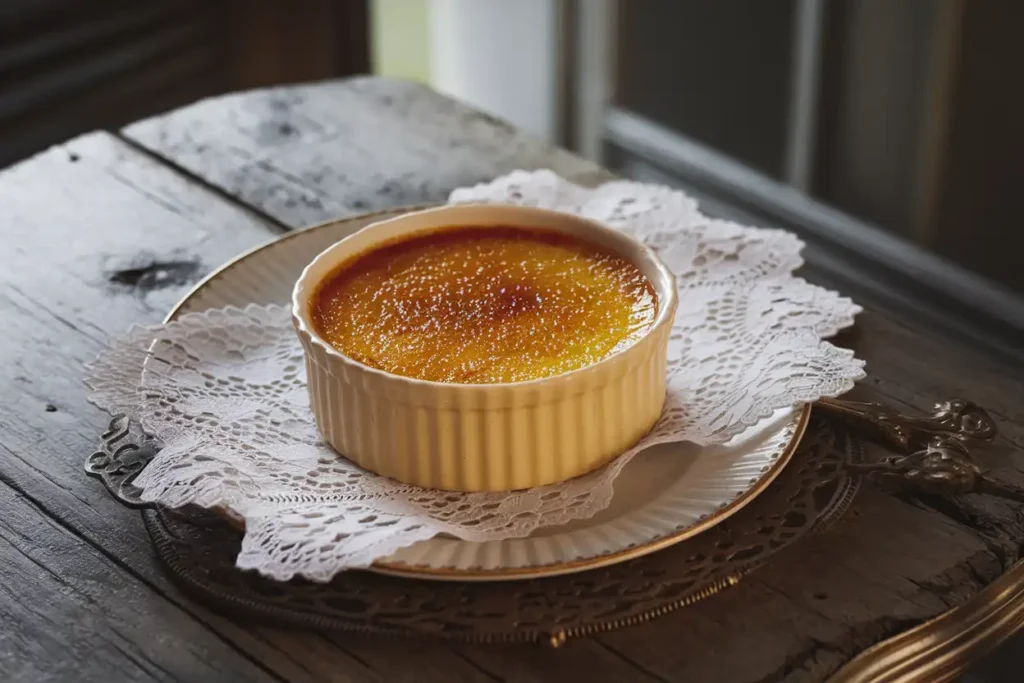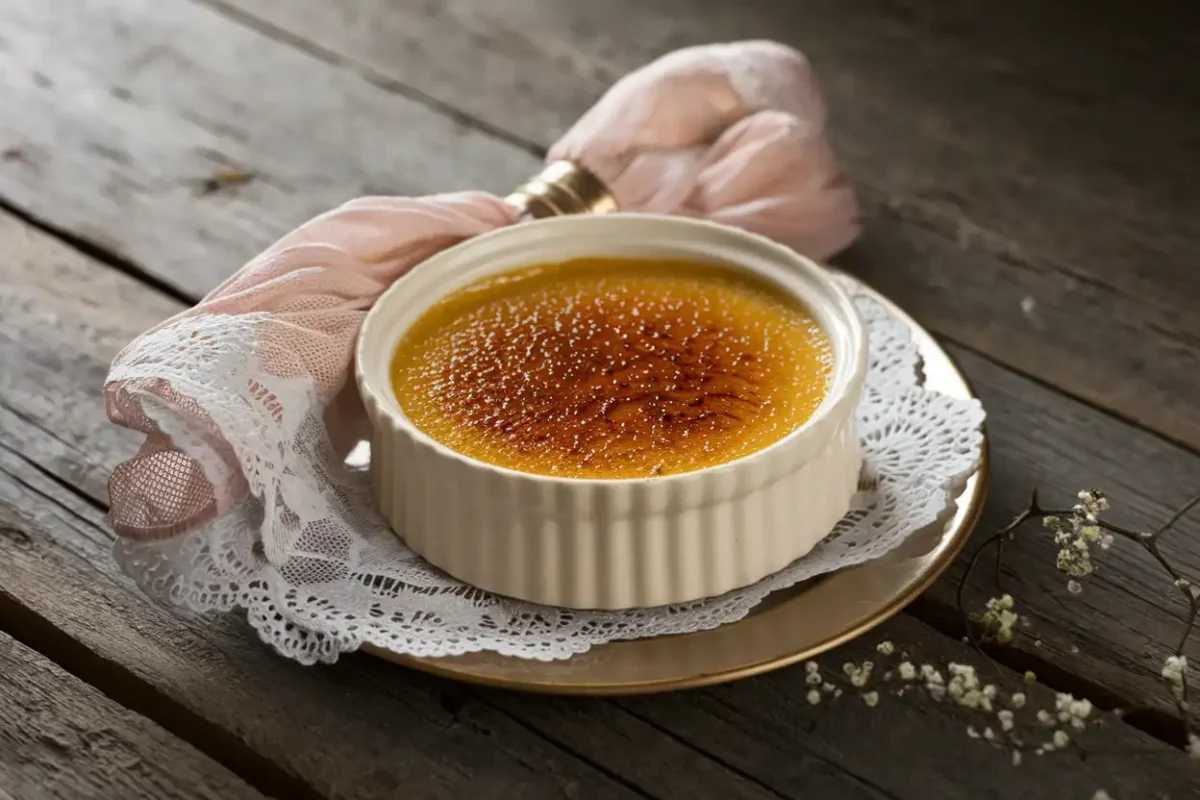Crème brûlée—a name that dances off the tongue as delicately as the dessert itself. This French classic, with its silky custard and caramelized sugar topping, has captured hearts worldwide. But what makes it so irresistible? From its rich history and mouthwatering texture to the tips for perfecting it at home, this guide dives deep into the sweet world of crème brûlée. Whether you’re a culinary enthusiast or a dessert lover, this article covers everything you need to know, including fascinating FAQs and lesser-known facts. So, let’s embark on this delicious journey.
Table of contents
- What is Crème Brûlée?
- The History of Crème Brûlée
- What Makes Crème Brûlée So Special?
- How to Make Classic Crème Brûlée at Home
- Popular FAQs About Crème Brûlée
- Pairing Crème Brûlée with Other Foods and Drinks
- Nutritional Information and Healthier Alternatives
- Fun Facts and Trivia About Crème Brûlée
- Conclusion: Why Crème Brûlée Is More Than Just a Dessert
What is Crème Brûlée?
Origins and Meaning of Crème Brûlée
At its core, crème brûlée translates to “burnt cream” in French. The name refers to its iconic caramelized sugar topping, which is carefully torched to a golden-brown hue. This dessert epitomizes simplicity and sophistication, combining just a handful of ingredients to create culinary magic.
Synonyms and Regional Variations
Though crème brûlée is the darling of French cuisine, it shares striking similarities with other desserts. For instance, crema catalana from Spain boasts a nearly identical flavor profile but uses a citrus zest twist. In England, a similar dish called “Trinity cream” emerged centuries ago, showcasing slight regional adaptations.
The Literal Translation of Crème Brûlée and Its Cultural Significance
Beyond its literal translation, crème is a symbol of indulgence and celebration. Served at weddings, upscale dinners, and even casual brunches, it’s a dessert that bridges the gap between elegance and comfort. Its enduring appeal lies in its ability to elevate any occasion with a delicate crunch and creamy base.
Crème isn’t just a dessert; it’s a reflection of culinary craftsmanship and a testament to the power of simplicity. With its universal appeal and timeless charm, it’s no wonder this treat continues to enchant taste buds across the globe.
The History of Crème Brûlée
Tracing the Roots of Crème Brûlée in French Cuisine
The origins of crème brûlée are steeped in the rich culinary traditions of France, yet its history isn’t as straightforward as you might think. Records suggest that similar desserts existed as early as the 17th century, with recipes appearing in French, Spanish, and English cookbooks. Despite some debate over its exact birthplace, the dish is undeniably a hallmark of French gastronomy. The delightful combination of smooth custard and caramelized sugar made it a favorite among royals and the upper class.
Evolution Over Centuries: From Trinity Cream to Modern Times
Interestingly, an English version known as “Trinity cream” predates the classic French version. Created at Trinity College in Cambridge, this dessert introduced the idea of branding the school crest on its sugar top using a hot iron. Over the years, crème has shed its aristocratic ties to become a widely celebrated dish. Today, it graces menus worldwide, from fine dining establishments to casual bistros.
Comparison: Crème Brûlée vs. Crema Catalana
The Spanish crema catalana is often compared to crème brûlée. While both feature a creamy base and caramelized sugar, crema catalana uses milk instead of cream and adds a hint of citrus zest and cinnamon. This regional variation highlights how culinary techniques adapt to local ingredients, showcasing the dessert’s versatile charm.
What Makes Crème Brûlée So Special?
The Appeal of Contrasting Textures: Smooth Custard and Crispy Sugar
One bite of crème reveals why it’s such a crowd-pleaser. The creamy custard base, often infused with vanilla or other subtle flavors, is perfectly complemented by the crisp layer of caramelized sugar. The contrast between textures creates a sensory experience that keeps people coming back for more.
Flavor Profiles: What Does Crème Brûlée Taste Like?
The hallmark of crème brûlée is its rich, velvety custard. Its base flavor is typically vanilla, but modern variations include hints of coffee, chocolate, or citrus. The torched sugar layer adds a caramelized sweetness and slightly bitter edge, balancing the dessert’s richness.
Why It’s a Favorite for Special Occasions
Crème brûlée embodies elegance, making it a go-to dessert for celebrations and romantic dinners. Its dramatic presentation—cracking the sugar crust with a spoon—adds a touch of theater to dining experiences. Whether at a wedding or an intimate gathering, this dessert never fails to impress.
How to Make Classic Crème Brûlée at Home
Essential Ingredients for a Perfect Crème Brûlée
Making crème brûlée at home requires just a handful of ingredients: heavy cream, sugar, egg yolks, and vanilla extract. The simplicity of the recipe means that each ingredient plays a crucial role, so using high-quality cream and fresh eggs will elevate the final dessert. For an aromatic twist, you can experiment with vanilla beans or citrus zest.
Step-by-Step Preparation Method
- Heat the Cream: Begin by warming the cream gently over low heat. Add vanilla extract or a split vanilla bean for flavor.
- Mix the Yolks and Sugar: Whisk the egg yolks and sugar until pale and creamy.
- Combine Cream and Yolks: Gradually add the warm cream to the yolk mixture, whisking constantly to prevent curdling.
- Bake in a Water Bath: Pour the mixture into ramekins and place them in a baking dish. Add hot water to the dish to create a water bath, ensuring even cooking.
- Chill and Torch: After baking, chill the custards in the refrigerator. Before serving, sprinkle sugar on top and caramelize it using a kitchen torch.
Common Mistakes to Avoid
- Overcooking: Keep a close eye on the custard during baking. It should jiggle slightly in the center when done.
- Too Much Sugar on Top: A thin, even layer of sugar ensures the perfect crack when torched.
- Skipping the Chill: Proper chilling allows the custard to set and enhances the creamy texture.
Tips for Achieving the Perfect Caramelized Sugar Top
The crunchy sugar crust is arguably the most iconic element of crème . Use superfine sugar for an even caramelization and hold the torch at a consistent distance to avoid burning.
Variations: Chocolate, Coffee, and Beyond
While vanilla is classic, crème can be customized with endless flavors. Add melted chocolate to the custard for a rich twist, or infuse the cream with espresso for a coffee-lovers’ dream. The possibilities are as limitless as your imagination!
Popular FAQs About Crème Brûlée
What Does Crème Brûlée Taste Like?
Crème brûlée boasts a creamy, custard-like texture and a rich vanilla flavor, topped with a caramelized sugar crust that adds a satisfying crunch. The balance of sweetness and subtle bitterness from the sugar topping makes it a universal favorite.

What is the Difference Between Crème Brûlée and Crema Catalana?
Though similar, the two desserts differ in key ways. Crema catalana uses milk instead of cream and incorporates citrus zest and cinnamon. It’s also traditionally torched with a hot iron, adding a rustic touch.
What is Crème Brûlée Made Of?
At its simplest, crème consists of heavy cream, egg yolks, sugar, and vanilla. These humble ingredients come together to create a dessert that’s both elegant and indulgent.
Why Do People Love Eating Crème Brûlée?
The allure of crème brûlée lies in its texture and flavor. The creamy custard contrasts beautifully with the crunchy sugar topping, creating a dessert that’s as enjoyable to eat as it is to make. Its elegance and versatility make it a show-stopping treat for any occasion.
Pairing Crème Brûlée with Other Foods and Drinks
Dessert Wines and Beverages That Complement Crème Brûlée
Crème brûlée pairs beautifully with dessert wines, such as Sauternes or Moscato. These sweet wines enhance the vanilla custard’s richness while balancing the caramelized sugar’s bittersweet notes. If you prefer something lighter, a glass of sparkling wine or Champagne adds an effervescent contrast to the dessert’s creamy texture.
For non-alcoholic options, coffee is a classic choice. The slight bitterness of an espresso or the creaminess of a cappuccino complements crème perfectly. Similarly, a well-brewed tea, especially Earl Grey or jasmine, can offer subtle floral or citrus undertones to elevate the experience.
Serving Suggestions: Accompaniments to Enhance the Experience
Although crème brûlée is a star on its own, thoughtful accompaniments can take it to the next level. A handful of fresh berries—like raspberries or blackberries—adds a pop of color and a refreshing tartness that cuts through the richness of the custard. Alternatively, a light, buttery shortbread cookie provides a delightful textural contrast.
For those seeking an adventurous twist, consider serving crème brûlée alongside a small scoop of sorbet. The icy, tangy sorbet juxtaposed with the warm caramelized topping creates an unforgettable flavor duo.
Nutritional Information and Healthier Alternatives
Caloric Breakdown of Traditional Crème Brûlée
Traditional crème brûlée is undeniably indulgent. A single serving typically contains around 200–300 calories, depending on the recipe. The dessert’s richness comes from its heavy cream, sugar, and egg yolks. While it’s not an everyday treat, enjoying it occasionally is a delightful indulgence.
Lightened-Up Versions: Low-Sugar and Dairy-Free Options
For those looking to enjoy crème without the guilt, healthier variations are a fantastic option. Swap heavy cream for coconut cream or almond milk to create a dairy-free version that’s just as creamy. Using a natural sweetener, like stevia or honey, can reduce the sugar content without compromising the flavor.
Another tip is to reduce the portion size by serving the custard in smaller ramekins. This not only cuts calories but also allows you to savor the dessert in moderation. With a few tweaks, crème can be a lighter, yet equally satisfying, treat.
Fun Facts and Trivia About Crème Brûlée
Crème Brûlée in Pop Culture
Crème brûlée isn’t just a dessert—it’s a symbol of elegance and indulgence that’s often featured in pop culture. From romantic dinner scenes in movies to appearances in cooking shows, this dessert consistently takes center stage. In the classic film Amélie, for example, the protagonist’s joy in cracking the sugar crust embodies the simple pleasures of life. This cultural spotlight has only heightened its global appeal.
Interesting Records and Variations Worldwide
Did you know that the largest crème ever made weighed over 1,600 pounds? This record-breaking feat showcased the dessert’s popularity and its ability to inspire culinary creativity on a grand scale. Around the world, chefs experiment with unique variations, like matcha-infused custards in Japan or savory versions featuring ingredients like foie gras or crab.
These fun tidbits remind us that crème is more than just a dessert—it’s a canvas for creativity and a cultural icon.
Conclusion: Why Crème Brûlée Is More Than Just a Dessert
Crème Brûlée as a Culinary Symbol
Crème brûlée isn’t just a dessert—it’s an experience. From its silky custard to the satisfying crack of its caramelized sugar topping, this French classic captures the essence of indulgence and craftsmanship. Its universal appeal lies in its ability to transform simple ingredients into a sophisticated delight. Whether served at an upscale dinner or enjoyed in the comfort of home, crème continues to enchant dessert lovers worldwide. As both a culinary masterpiece and a symbol of elegance, it truly deserves its place as a timeless favorite.
For an example of modern twists, check out this Crab Brûlée Recipe that combines tradition with a savory flair.

